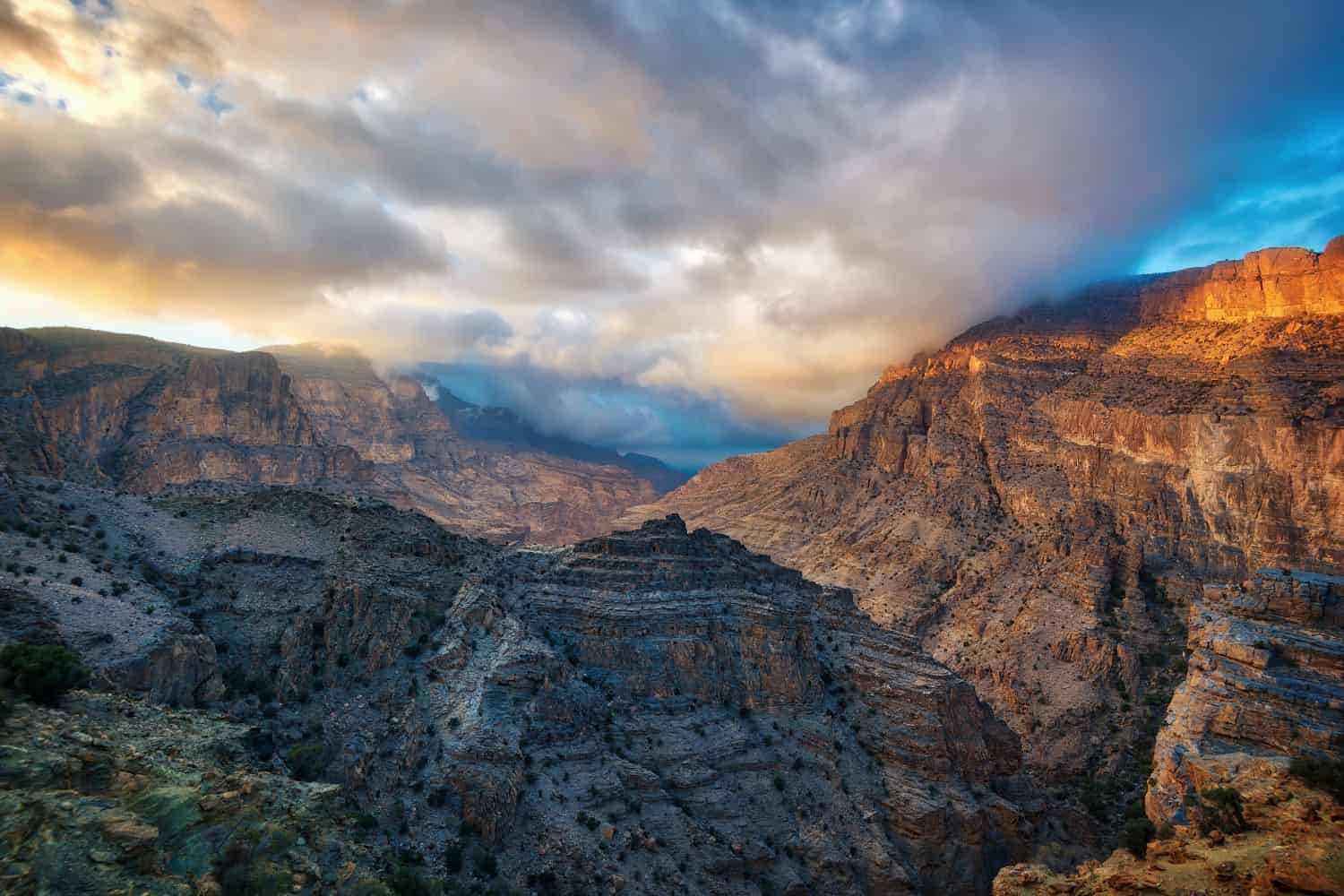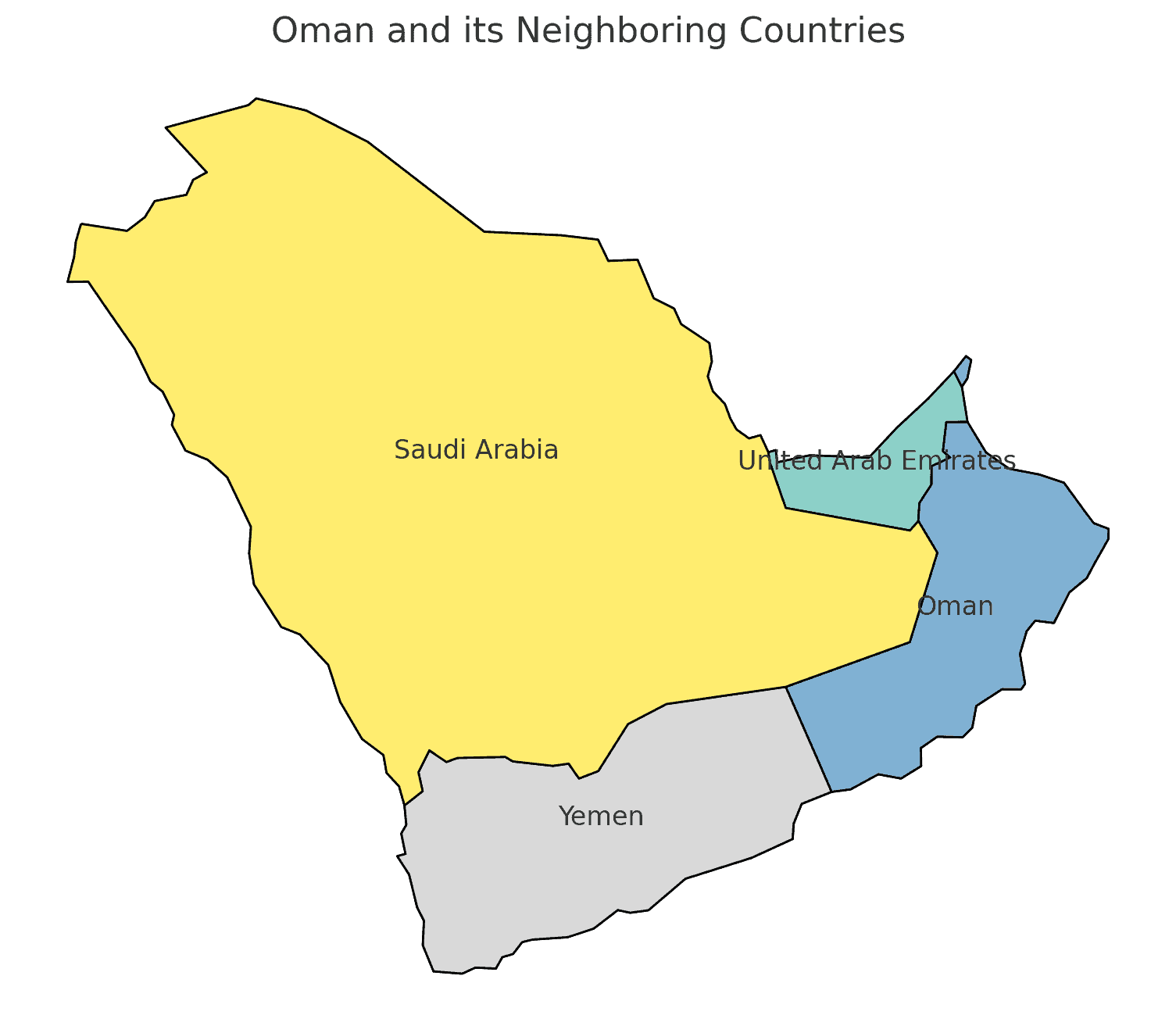Table of Contents
The geography of Oman is a captivating blend of diverse landscapes and historical significance. Located in the Middle East, on the southeastern coast of the Arabian Peninsula, Oman’s geographic position has been instrumental in shaping its history and cultural identity.
Enclosed by the vast Arabian Desert, Oman geography lures adventurous travelers with its expansive sand dunes, stunning Hajar mountains, and pristine coastline. From wandering through the wadis of Dhofar to diving into the rich history of Muscat, Oman’s contrasting terrains and deep-rooted traditions present an unforgettable journey for intrepid tourists seeking a unique and enriching experience.
The physical geography of Oman reveals a canvas of striking natural wonders. From the crystal-clear waters of the Bimmah sinkhole, showcasing the nation’s intricate karst topography, to the diverse ecosystems that range from the lush green Salalah plains during the Khareef season to the vast, sunbaked deserts, Oman stands as a testament to nature’s majesty.



Top Geographic Features of Oman
- Hajar Mountains: Dominating the northeastern corner of Oman, the Hajar Mountains deeply influence the region’s topography and climate. Jebel Shams, the highest peak, is often called the “Grand Canyon of Oman” for its breathtaking views.
- Wadi Shab: One of Oman’s most famous wadis, Wadi Shab is situated in the Al Sharqiyah region. Its crystal-clear waters and spectacular caves make it a popular destination for locals and tourists.
- Al Batinah Coastal Plain: Stretching along the northern coast of Oman, this fertile plain is vital for the country’s agriculture, including date palm plantations.
- Rub al Khali (Empty Quarter): Part of this immense sand desert extends into the western part of Oman. Characterized by its enormous sand dunes and extreme temperatures, it remains one of the most uninhabited places on Earth.
- Salalah Coast: Located in the Dhofar region, the coast undergoes a seasonal transformation during the Khareef (monsoon) season, turning the usually arid landscape into lush green pastures.
- Al Hajar Ash Sharqi Range: Situated in the eastern part of Oman, this range has rugged terrains, deep wadis, and diverse wildlife.
- Wadi Dayqah: An important wadi located in the Quriyat region, Wadi Dayqah boasts one of Oman’s largest dams, playing a significant role in water conservation and agriculture.
- Ras Al Jinz Turtle Reserve: Located on Oman’s eastern shores, this reserve is globally recognized for its green turtle nesting grounds, attracting thousands of visitors annually.
- Musandam Peninsula: Jutting out into the Strait of Hormuz, this peninsula is known for its fjord-like inlets, called khors, and its vibrant marine life, including dolphins.
- Sharqiyah Sands: Previously known as the Wahiba Sands, this desert region is famous for its beautiful dunes and the traditional Bedouin lifestyle.
These geographic features are instrumental in shaping Oman’s landscape, climate, and cultural heritage, making them fundamental in defining the country’s geography.
Oman Geography

Exploring the Oman National Geographic canvas unveils an awe-inspiring assortment of Oman geographic features. From the rugged Al Hajar mountains to the vast Wahiba Sands desert and the lush Salalah region, the country offers an enchanting mosaic of natural treasures.
- Mountain Ranges – The Crown of Diversity: Just as documentaries showcase impressive mountain ranges, Oman is proud of the Al Hajar range. These towering cliffs do more than just beautify the nation; they are a haven for unique biodiversity and have influenced Oman’s cultural narrative.
- Wadis – Nature’s Oasis: Oman’s famous Wadis, like Wadi Shab and Wadi Bani Khalid, resemble the paradise-like settings seen in photographs. This oasis, set amidst barren landscapes, signifies the region’s geological wonders.
- Deserts – Golden Dunes and Endless Horizons: Much like documentaries that explore vast terrains, Oman’s Wahiba Sands highlights endless dunes that shelter a diverse set of creatures. This golden sea narrates tales of Bedouin traditions and the nation’s desert legacy.
- Historical Sites – Time’s Footprints: Oman’s historical landmarks, such as the forts of Nizwa and Bahla, bring to life expeditions that discover ancient epochs. These relics are a testament to the nation’s deep-rooted heritage.
- Ethnic Diversity – A Cultural Tapestry: Echoing National Geographic’s emphasis on varied cultures, Oman is a blend of ethnicities, including Arabs, Baluchis, and Afro-Omanis. Each community enriches the nation with distinct traditions, dialects, and customs, weaving a colorful cultural fabric.
- Wildlife – Desert’s Guardians: Oman’s conservation areas, like the Ras al Jinz Turtle Reserve, reflect the commitment to wildlife preservation. These sanctuaries act as essential refuges for various species, safeguarding biodiversity in diverse settings.
- Geological Marvels – Earth’s Artwork: The country’s geological gems, such as the Al Hoota Cave, highlight Oman’s natural allure amidst the commanding Al Hajar. These formations exhibit the artistic strokes of nature’s power.
- Remote Exploration – Mystical Terrains: The secluded and pristine regions of Dhofar beckon explorers, akin to ventures into unseen lands. This expansive realm offers insights into pristine landscapes and peculiar ecosystems.
Oman geographical attributes are accentuated by the commanding presence of the Al Hajar mountain range. These imposing heights, which adorn the northeastern part of the country, set a dramatic scene for the nation’s varied topography. The ancient frankincense trade routes, once central to regional commerce, snake their way through these mighty mountains, connecting corners of Arabia.
Meandering harmoniously through Oman’s landscape are the nurturing wadis and water systems, crucial for agriculture and sustenance. Moreover, the expansive Wahiba Sands and coastal plains contribute to the country’s distinct geography.
Oman Geographic Location

Oman geographic location is highly strategic, and its position has been pivotal throughout history. Located in the southeastern part of the Arabian Peninsula, the country has been a center for trade, culture, and ideas, highlighting its historical importance.
Borders of Oman
Oman shares borders with three countries. Here is Oman physical geography with the neighboring countries and the approximate total length of each border:
- Saudi Arabia: The border between Oman and Saudi Arabia is approximately 676 kilometers long, making it the longest international border for Oman.
- United Arab Emirates (UAE): The border between Oman and UAE is approximately 609 kilometers long.
- Yemen: The border between Oman and Yemen is approximately 293 kilometers long.

| Oman Neighboring Country | Border Length (Approximate) |
|---|---|
| Saudi Arabia | 676 kilometers |
| United Arab Emirates (UAE) | 609 kilometers |
| Yemen | 293 kilometers |
These international borders define Oman’s connections to different regions and accentuate the country’s geopolitical significance as a juncture between the Arabian Peninsula and the eastern stretches of the Middle East.
Geography of Muscat Oman

As the capital city of Oman, Muscat is a captivating microcosm of the country’s human geography. Here, various ethnic groups, including Omani Arabs, Baluchis, South Asians, and East Africans, coexist, contributing to the city’s vibrant cultural tapestry.
Muscat, the capital city of Oman
- City of Contrasts: Muscat is known for its stark contrasts, where modern high-rises coexist with traditional souks, creating a unique blend of old and new.
- Gulf of Oman: The Gulf of Oman borders the city, playing a significant role in its trade and transportation.
- Muscat’s Elevation: The city is nestled between the sea and the Al Hajar Mountains, with coastal plains and rocky hills surrounding it.
- Green Spaces: Muscat is home to several beautiful parks and gardens, including Riyam Park, offering a serene escape amidst the bustling city.
- Muscat’s Historical Significance: With a history deeply rooted in ancient maritime trade, Muscat has witnessed various epochs and played a pivotal role in Middle Eastern politics and trade.
- Diverse Architecture: The city showcases a diverse architectural heritage, reflecting influences from Arabic, Persian, and modern styles.
- Omani Culture: Muscat is a hub for traditional Omani music and dance, and its vibrant culture can be seen and heard throughout the city.
- Al Jalali and Al Mirani Forts: The historic forts, located in the heart of the city, are iconic symbols of Oman’s political and military history.
- Muscat’s Economy: The city serves as Oman’s economic and cultural hub, attracting people from all over the country seeking opportunities and education.
- Population Growth: Muscat has experienced steady population growth, with a significant influx of expatriates from various countries, leading to urbanization and infrastructure challenges.


Historical Geographical Importance of Oman
Throughout the ages, Oman’s geographical significance has made it a sought-after stage for historical drama. As empires and nations rose and fell, from the Persians to the indigenous tribes and Arab settlers, Oman geographic position played a pivotal role in shaping the world’s history.
- Strategic Gateway: Oman’s location as a gateway between the Arabian Sea and the vast expanse of the Arabian Peninsula has made it a strategic point for trade, cultural exchange, and military endeavors throughout history.
- Ancient Trade Routes: The ancient trade routes, notably the Incense Road, passed through Oman, connecting various civilizations and facilitating the exchange of goods, ideas, and cultures.
- Persian Influence: Oman was a key territory influenced by the Persians during ancient times, leaving its mark on the region’s history.
- Wars of Independence: During various eras, Oman sought to establish its sovereignty, resisting foreign dominance and influence from larger neighbors.
- Arab and Islamic Expansion: Oman’s geographic position contributed to its pivotal role in the early Islamic expansion, and the spread of Ibadhism, a branch of Islam distinct to the country.
- Influence of Indigenous Tribes: Oman was home to various indigenous tribes, influencing its early history, culture, and trade dynamics.
- Portuguese Occupation: The European invasions of the 16th century, notably by the Portuguese, had a profound impact on Oman’s history, leading to a blend of cultures and traditions.
- Deserts and Dhows: The vast deserts of Oman and the iconic dhow ships, symbols of the nation’s maritime tradition, have become representative of the nation’s cultural and historical identity.
- Influence of Omani Folk Music: Oman’s unique cultural blend gave rise to traditional Omani folk music, an art form that has since captivated local traditions, influencing its culture, art, and lifestyle.
The geographical position of Oman is a unique blend of natural beauty and historical significance. Nestled at the southeast corner of the Arabian Peninsula, it boasts a diverse landscape that includes stunning beaches, vast deserts, and rugged mountain ranges. Oman’s extensive coastline along the Arabian Sea and its proximity to ancient maritime trade routes have played a crucial role in its development as a trading hub, reflecting a rich cultural heritage influenced by a variety of civilizations.
In conclusion, Oman’s geographical importance has been central to its historical narrative. From the times of ancient maritime trade to the modern era, its strategic location has made it a key player in regional affairs. The country’s position at the crossroads of maritime routes between the East and the West has not only shaped its history but also had a significant impact on broader historical developments and continues to be influential in the geopolitics of the Middle East today.
More About Oman
[the-post-grid id=”50404″ title=”Oman Main page”]
